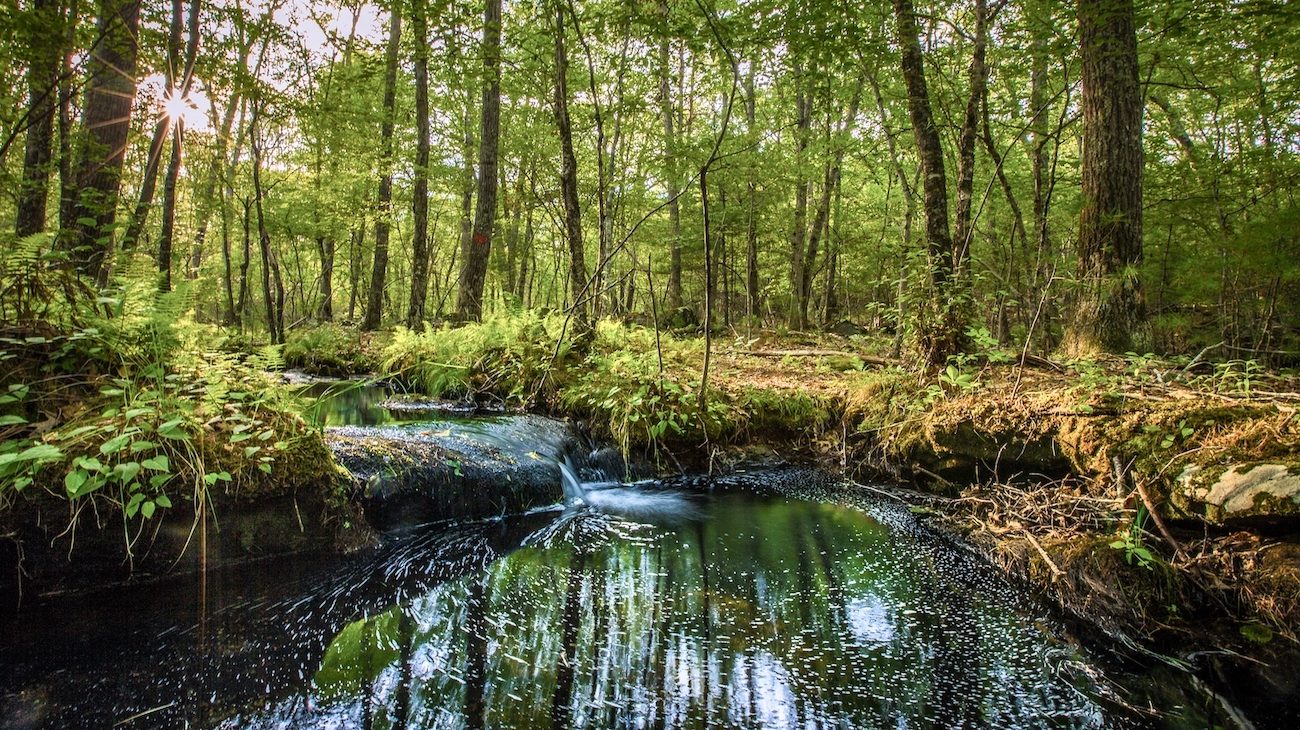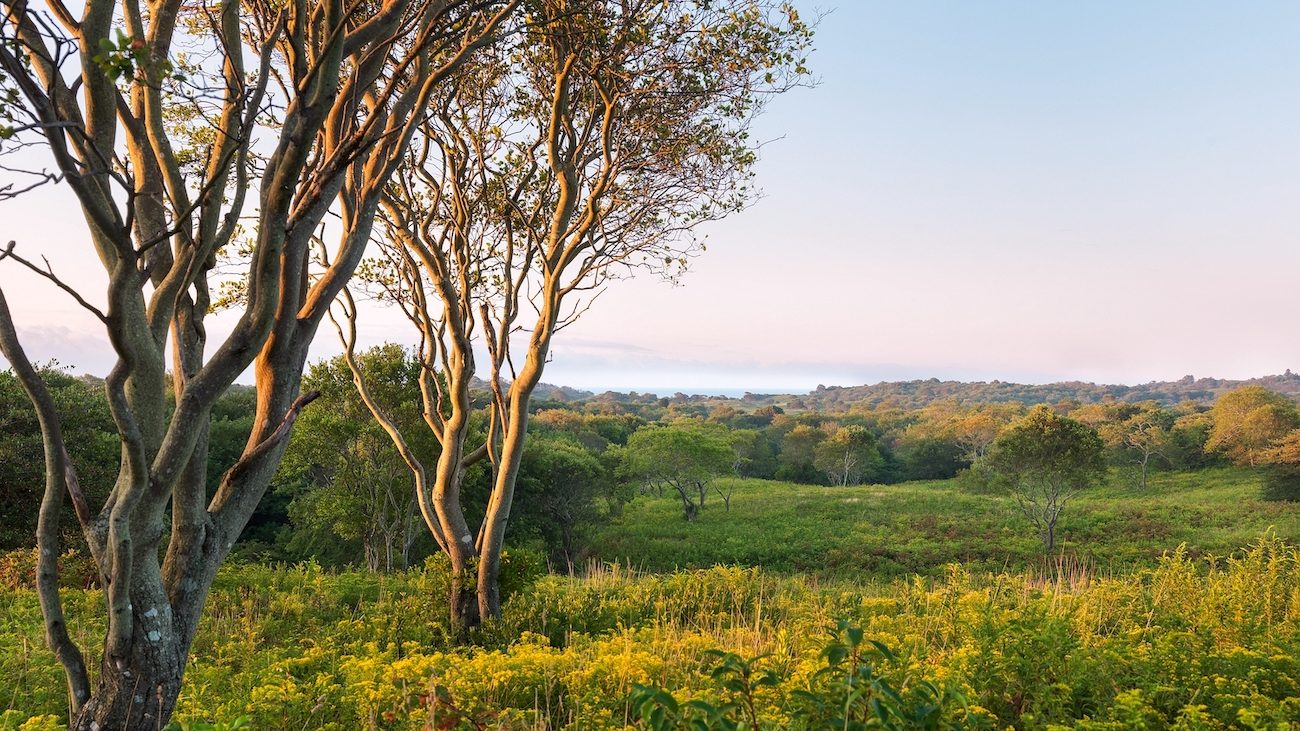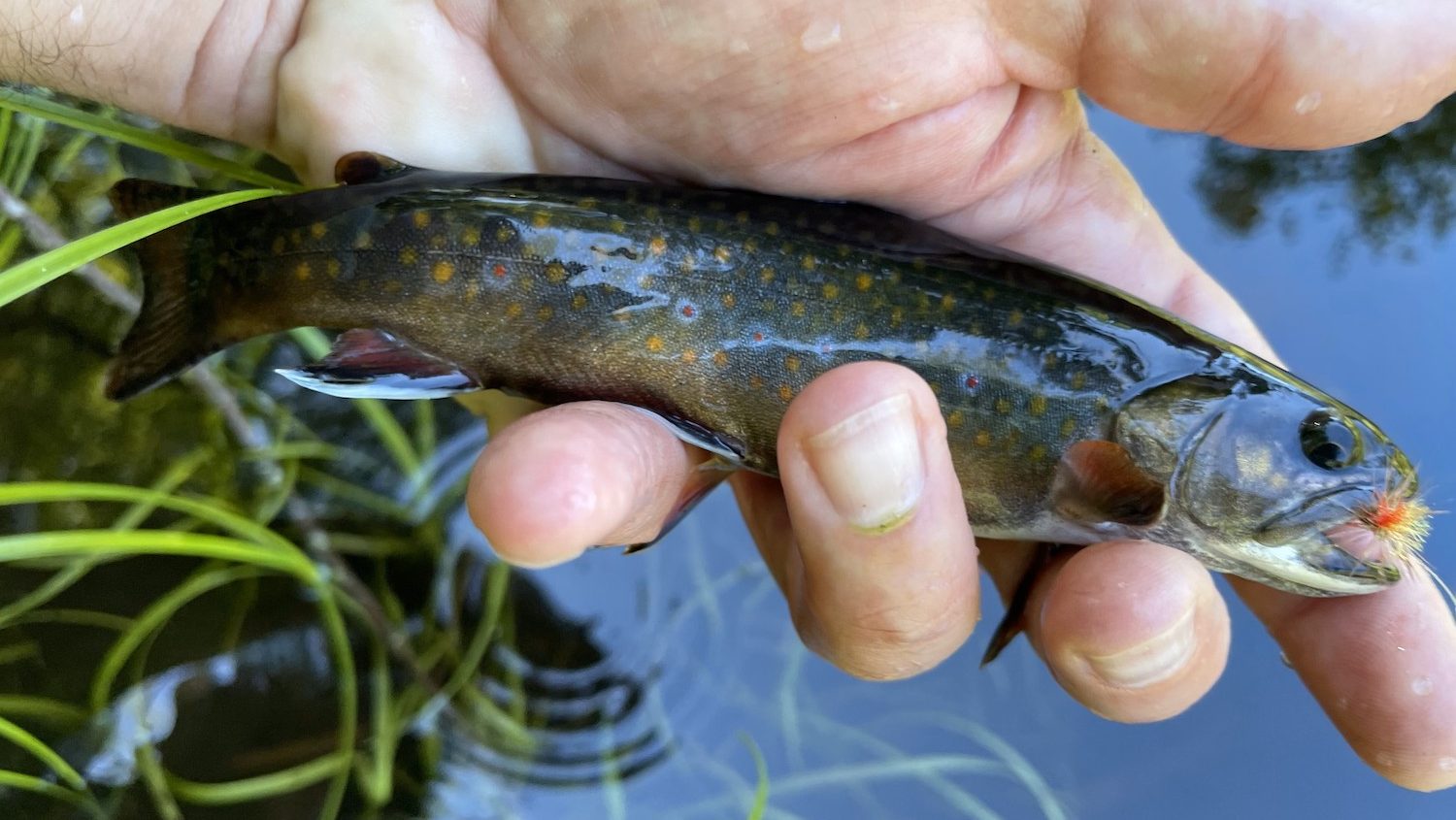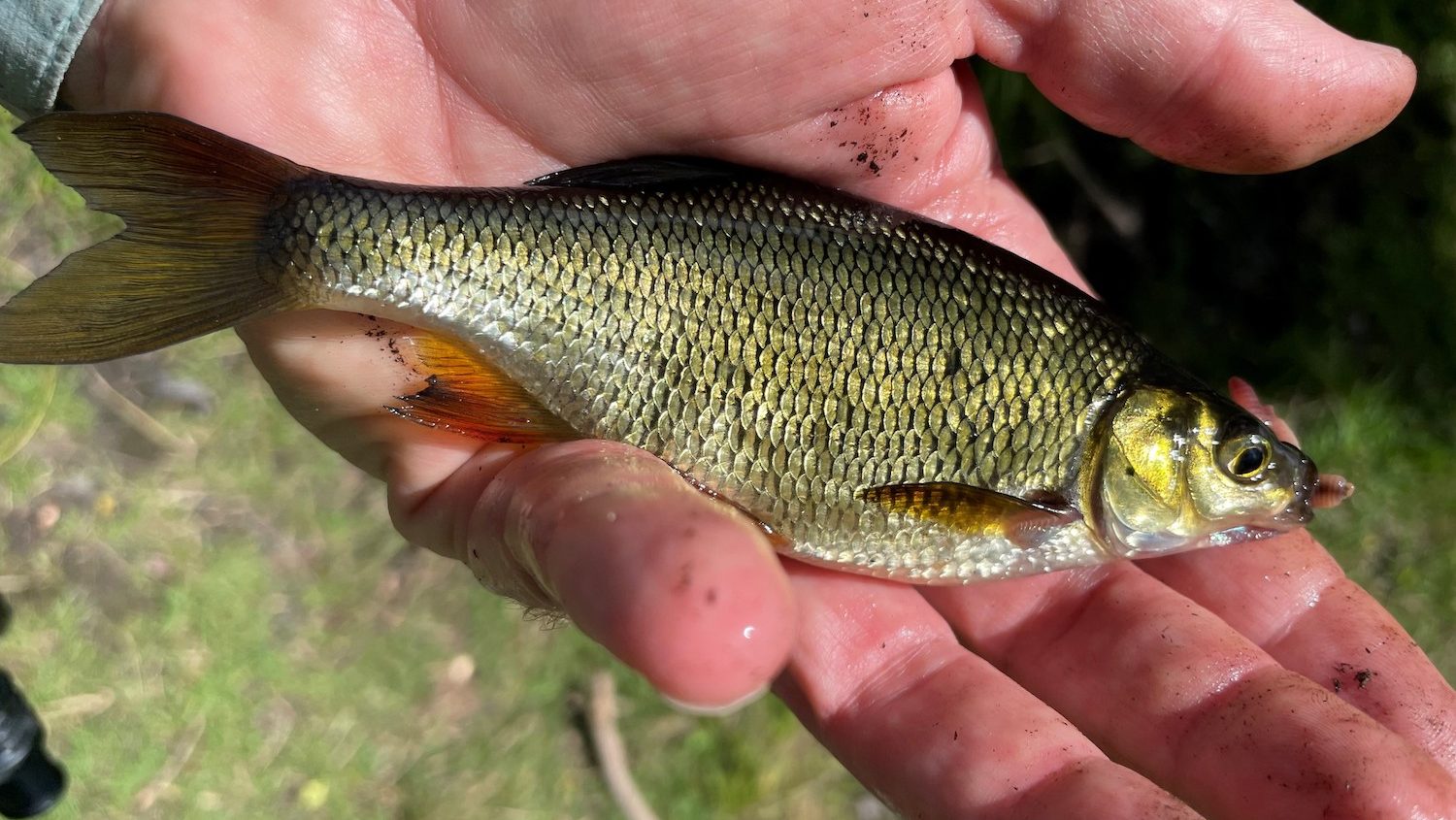I’m on a quest to catch a fish in each of the 50 U.S. states – and to use each adventure as a means to explore conservation, the latest fisheries research and our complicated connections to the natural world.
It was a pleasant June morning, a bit of humidity in the air, as we headed down a little path through eastern hardwood forest. I carried a light fiberglass fly rod. The sound of a mountain stream tempted me, but I followed my new friend, who was taking me to his secret pond. One of those places where he might take one person a year, the kind of place you’re sworn to never reveal.
We were after wild brook trout, a classic eastern fly-fishing experience.
Brook trout are native to the eastern United States streams where the American fly fishing tradition originally took hold. But brook trout have disappeared from much of their original range, imperiled by all the usual factors including habitat loss, climate change, acid rain and especially the introduction of non-native brown and rainbow trout.
Today, most often found in headwater mountain streams and remote lakes. For a certain type of angler, including me, this adds to their mystique. A search for “brookies” takes you to beautiful creeks in quiet forests. Anglers know the classic places to catch them, like Maine’s Rangeley Lakes, Shenandoah National Park, the Smoky Mountains.
But they are also found in surprising places, pockets of wildness in heavily populated or altered landscapes. Two of my favorite native brook trout experiences were in beautiful streams located in New Jersey and Iowa.
And today: Rhode Island.
Wild brook trout in Rhode Island? I have read a couple recent books celebrating brook trout fishing, both somewhat exhaustive in approach, and neither even mentions Rhode Island. But the smallest state will soon provide one of my most memorable mornings of brook trout fishing.

New Friends and Secret Ponds
When John Torgan, state director for The Nature Conservancy in Rhode Island, found out I was going to be in Rhode Island during a family vacation, he called me within a few minutes and invited me out for a morning of fishing.
A few minutes into the call, I recognized a kindred spirit. In his younger years, he worked on a charter boat. He told me of trophy striped bass and shared a story of catching a clown knifefish, a bizarre exotic recently established in Florida. Despite his big-fish experience, he also had a passion for exploring small streams for brook trout.
“Some anglers wonder why you’d go searching for 6-inch trout when you could be out in the saltwater,” he says. “But it sounds like you understand.”

I did. I live for exploring blue lines on the map and crawling after native cutthroats, redband trout and brookies. And so we set up a time to meet for a morning during my upcoming trip.
John was at my hotel to pick me up bright and early, and we fell into an easy conversation on fishing, conservation and wild places. Rhode Island may be the smallest state but John filled me in on the impressive history of conservation here.
Efforts by TNC and partners, for instance, have protected nearly half of Block Island as open space. I’d visit that spectacular island later with my family, wishing much of the day that I’d brought along my fly rod as striped bass cruised the clear waters just feet away from me.

We drove along a side road into a little parking area, a trailhead into a nice patch of forest. John again swore me to secrecy on this spot, his favorite place to pursue brookies. We headed down the trail and took a discrete side path, soon arriving at a beautiful wooded pond.
John pointed from where we stood. “I usually can catch a fish right here,” he said. He then handed me a sparkly streamer fly that he tied. In a few minutes I was casting out, stripping back the streamer in little jerks.
I continued casting for 15 minutes or so. “I didn’t think it would be this hard,” John said, with a bit of that concern that comes whenever you take a guest fishing.
I enjoyed casting in a new place and figured I’d start moving around the pond, prospecting for fish.
I heard a slight splash, as did John. A feeding fish, on the other side of the pond. A few minutes later, I saw another rise, quickly followed by another. “I’ll head over there and see if I can fool one,” I said.
I walked over and stood by a large tree, scanning the surface. There. A clear rise. I tied on a parachute Adams dry fly, a fly pattern that floats on the surface (and is easy for my eyes to see).

A Cast in the Pond
In a stream, a trout will often hold in likely cover and feed on insects as they float by. It’s not unusual to see a fish rising repeatedly in the exact same spot. While your cast has to be accurate, you also know exactly where to drop the fly.
In still waters, this is often not the case. Trout cruise around, picking off insects they encounter on the surface. When you see a rise, it can be a guessing game. Where is the fish going next? You try to establish a pattern as the rises move across the surface.
I saw the rise, and took a guess. Nothing. John, meanwhile, had a fish on. It was not a brook trout, but a golden shiner, another native fish. I had caught one a couple days earlier, after a somewhat difficult day trying to catch a Connecticut fish (the 42nd state where I’d caught a fish).

I saw another rise, suggesting the fish might be moving to the right. I made a cast in the vicinity. Waited a couple seconds. I was about to lift my line for another cast when my fly disappeared.
And just like that, my line was tight to my first Rhode Island brook trout. I stripped in line. A 6-inch fish, pretty typical for such waters. I kept the fish in the water as I admired its red spots haloed by white rings. Brook trout are salmonids, but are not actually trout. They’re char, distinguished from trout by their lack of black spots.
I slipped the brookie into the water and it swam off. A couple casts later, I caught another fish, then another. I sat for a moment and just took in the spot, a quiet forested pond in a small eastern state.

Brook Trout in Rhode Island
John O’Brien, policy/partnership specialist for The Nature Conservancy in Rhode Island, later tells me that brook trout are holding on in the state.
“This is a small state that’s heavily industrialized and densely populated in many areas,” he says. “But there’s also a history of conservation that has protected open space that in turn has protected cold-water streams. You can find brook trout in many of the headwater streams.”

O’Brien, who worked for the Rhode Island Department of Fish and Wildlife for 37 years prior to joining TNC, noted that brook trout still face challenges, often due to the state’s history.
“The wreckage of colonization and industrialization is still there, on the landscape,” he says. “There are still remnant dams and road culverts that block fish passage and can increase water temperatures.”
He also won’t call them native brook trout, noting the fish genetics are different from what they were in the 1600s. That’s because more than 100 years ago, the state stocked hatchery brook trout to meet increasing sport fishing demand. But these are still the native species, found in their native habitat.
To ensure a future for brook trout in Rhode Island, conservationists are focused on removing remnant, outdated dams and improving road culverts. This improves the ability of fish to reach tiny headwater streams for breeding and as a refuge from warming waters.
“What we’re aiming for is improving the habitat,” he says. “There’s a lot involved in replacing culverts and removing dams. But if we systematically address that, brook trout can continue to have a bright future in Rhode Island.”

To the Sea
As we hike out from the pond, John Torgan tells me he has another spot he’d like to take me, this one far downstream. As we get out of the car, I can smell the salt.
Some brook trout in New England would move between fresh and saltwater. Called “salters,” they’re now greatly reduced in range due to the aforementioned stream blockages.
The spot John has taken me has fish that could move to the estuary. They exhibit the tendencies of salters, more apt to eat fish than insects. It’s a densely vegetated little stream.
More 50 Fish, 50 States
More stories from author Matt Miller's quest to catch a fish in each of the 50 US states.
I tie on a streamer and crawl through the brush, staying on my knees as I reach the stream. I tie on the sparkly streamer, designed to mimic a wounded minnow, John had given me earlier.
A deep little pool stretched out before me. I didn’t cast my fly; I flicked it. It drifted downstream and as it reached the end of its swing, the line went taut. I pulled up and felt a good fish bend my light fiberglass rod.
Just like that, it shook off. I flicked out another cast and almost immediately was tight to another fish. This time I kept the line tight and pulled the brook trout to the net. An absolutely beautiful fish, sleek and strong. After a quick photo, I slipped it back in the water.
“Want to try for another?” John asked.
But this one special fish, a secret brook trout within sight of the salt, was enough. More than enough.




Great account of another fish search in your 50 in 50 quest. What a treat to get fish on the secret pond on a dry and then a salter on a streamer!
What is your count now and what states do you have left in your quest?
Hi Ken,
I am at 46 states now, with Missouri, Oklahoma, Vermont and New Hampshire remaining. Possible in 2 trips. I have stories of several previous states coming soon.
Cheers,
Matt
Love brook trout —
NEVER lift from water except for seconds to unhook
NEVER touch except for 1- 2 seconds w/ very wet hand
NEVER identify locations
They are born/ live suspended in/ surrounded by water!
Become terrified/ mortally wounded by extraction from.